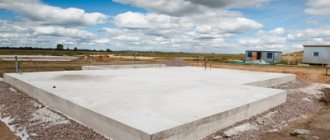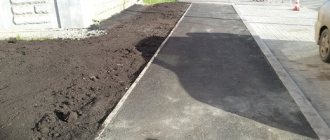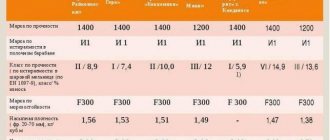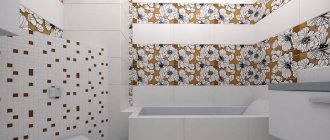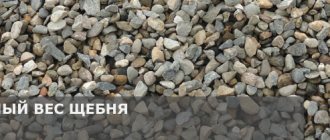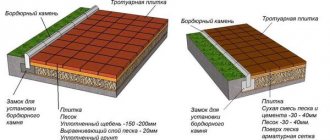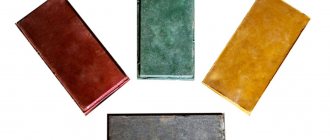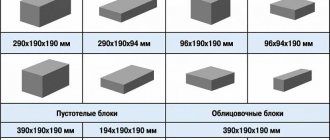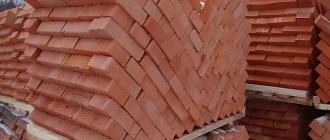- home
- Useful tips
It would seem that the question of how much paving slabs weigh should not greatly bother a customer who wants to see a path or platform on his or her personal plot. But in fact, everyone who knows about the intricacies of styling knows that too much depends on the weight indicator to ignore it. This includes the strength of the product, the installation technology, and the correct choice of base. If you don’t ask this question and let everything take its course, such a coating is unlikely to last long, and if it can’t withstand the weight, the base can easily sag. Next, we will tell you everything you wanted to know about the weight of vibro-pressed or vibro-cast paving slabs. We recommend vibration casting tiles.
| Name | Dimensions, mm | Weight, pcs./kg |
| Paving stones | 200x200x60 | 5,3 |
| Brick | 200x100x60 | 2.6 |
| Paving stones | 200x100x100 | 5,0 |
| 30x30x6 | 300x300x60 | 12,0 |
| Square | 400x400x60 | 21,0 |
| Square | 500x500x70 | 38,0 |
| Square | 500x500x60 | 34 |
| 8 bricks | 400x400x40 | 18.3 |
| Cloud, parquet, wave pattern | 300x300x30 | 4,8 |
| Coil | 225x136x60 | 3.3 |
| Wave | 240x120x60 | 4,0 |
| Old city | 1182x944x60 | 154,0 |
| Lawn grate | 600x400x80 | 27,0 |
| Sidewalk curb | 500x210x70 | 15.4 |
Production methods
Compliance with the manufacturing technology of this type of product ensures high-quality performance characteristics of the material. Requirements for slabs are regulated by the State Standard.
Structural elements can be purchased in Moscow and the Moscow region. Contacting companies involved in the production and sale of products allows you to purchase products that meet established standards. The production of structures on an industrial scale is organized in compliance with established standards and requirements.
Conveyor technology involves the use of vibration casting and pressing. Smooth concrete paving products are produced using the casting method, which involves pouring the mixture into prepared forms. When pressing, vibration equipment is used.
Forming products using vibration pressing involves the use of such materials and equipment as:
- concrete mixture;
- molds for filling;
- special additives that improve performance characteristics;
- mineral pigment;
- vibrating table.
The prepared mixture is poured into molds, pre-greased with oil and placed on the table. After formation, the polymerization process of the composition takes place within 2-3 days. It takes a week for final hardening. This fact must be taken into account when making paving elements in artisanal conditions.
Features and Specifications
Reinforced concrete slabs are a popular material in the building structures market. Thanks to its universal configuration and optimal dimensions, concrete paving slabs can be used for:
- territories of any type;
- public transport stops;
- urban highways;
- areas;
- park paths;
- playgrounds;
- flower beds;
- sidewalks;
- areas.
The products are designed for high weight loads and are resistant to deformation. The canvas made of slabs remains clean during the rainy season, and in the cold season it is safe for pedestrians, thanks to the rough surface.
The advantages of the material are as follows:
- the possibility of arranging entrance groups, recreation areas, courtyards;
- long service life;
- resistance to loads;
- external parameters;
- possibility of laying patterns, drawings;
- strength;
- ease of installation and care;
- convenience during dismantling associated with re-laying communications;
- the ability to imitate granite, marble and other natural materials.
Unlike facing material, paving slabs are made in the shape of a rectangle or square.
Products are not reinforced if their structural thickness allows. When the thickness exceeds 75 mm, structural reinforcement with wire is used. To lift and move structures, mounting loops with a diameter of 6 mm are introduced.
The slabs are made from a special concrete mixture in 1 or 2 layers. Products comply with specified production standards and meet GOST requirements. The water absorption rate of the products does not exceed 6%, strength - 3 MPa, wear resistance - 0.7 g/cm2.
Depending on the purpose, a distinction is made between concrete paving slabs and those for arranging the roadway. Road reinforced concrete products cover car parks and road surfaces. This group of structures involves the introduction of reinforcing reinforcement into the frame, which ensures operation of the slab under extreme load conditions.
The slabs are classified according to their purpose and a distinction is made between products intended for permanent and temporary roads. Designs may differ in composition and connection method. Products intended for arranging paving surfaces are presented in a wide range.
Depending on the configuration there are:
- square (K);
- decorative road elements (EDD);
- curly (F);
- rectangular (R);
- bordering (O);
- hexagonal (W).
Results
Today, in hardware stores and construction markets there is a huge selection of different tiles, in a variety of sizes, textures, as well as thickness and weight. This allows anyone to choose the tile that they like best. True, in addition to purely aesthetics, when choosing a tile you will also need to take into account its weight. Knowing this parameter, it will be possible to accurately calculate the load on the wall or floor, as well as select the most suitable adhesive for the most reliable adhesion of the tiles to the floor, wall or facade. Thus, knowing the weight of the tiles, it will be possible to make a truly high-quality and durable coating.
How to do it manually
When making structures yourself, you will need to prepare a concrete mixture of cement, sand and crushed stone, taken in a ratio of 1:1:2. To prevent the appearance of air pockets, it is recommended to add a plasticizer, which is 5% of the weight of cement.
A mineral dye is introduced along with the additives. Water is used in the amount necessary to prepare a solution of medium consistency. It is recommended to use a concrete mixer to prepare the mixture. The volume of solution is calculated based on the number of molds to be filled.
To control the uniformity of filling, use a building level. Self-production allows you to save money and produce styling elements of different configurations and colors.
You can simplify the task by using ready-made rubber molds. In their absence, pouring is carried out in self-made forms from a wooden panel with removable formwork. To ensure that finished products are easily removed, the inside is impregnated with hot drying oil.
Basic designations and dimensions
Conventional product markings are generated from a combination of numbers and letters separated by dots. In this case, the first numbers indicate the typical size of the slabs, the letter corresponds to the type of structure, and the indexation following it contains information about the thickness of the stone in cm.
The tile is square in size, 37.5 x 37.5 cm in size, 7 cm thick, and is marked “4.K.7”. The dimensions of reinforced concrete products for road construction are:
- length - 3-6 m;
- width - 1.2-2 m;
- height - 0.14-0.22 m.
Square-shaped products are produced with a side of 0.2, 1 m. The thickness of the structures depends on the purpose of the equipped fabric. The pedestrian path is laid with paving stones, 4-6 cm thick; in places of increased load, shaped elements with a thickness of 8 cm or more are required. If the height of the pavement is 4 cm, preliminary preparation of the concrete base is required.
Advantages
The indisputable advantages of laying paving slabs on roads, paths and sidewalks are:
- ease of installation,
- large selection of textures and colors,
- durability and abrasion resistance,
- environmental cleanliness,
- chemical inertness,
- frost resistance, heat resistance, moisture resistance,
- puddles do not form on the surface of properly laid paving slabs,
- The water balance of the soil is not disturbed, which is important for garden plots.
Weight of different types of tiles and porcelain tiles
To determine the mass of 1 m2 of ceramic tiles, it is important to take into account several parameters at once. These parameters are also taken into account when calculating the amount of tile adhesive required and when transporting the finishing material. It is recommended to distinguish between the following qualitative and quantitative indicators:
- weight of one product. This parameter means the weight of one tile. It is influenced by the density of the product, the material from which it is made, as well as the dimensions;
- specific gravity. This parameter is mainly influenced by the thickness of the finishing material, as well as its density. As a rule, ceramic tiles have the following indicators: 10-26 kg/m2;
- volumetric mass. This parameter shows the mass of tiles in 1m3 of finished products. For example, for glazed tiles this parameter is approximately 2050 kg/m3;
- Also, factors influencing the final weight of the product include its belonging to a specific type of tile. Thus, for different types of tiles, the weight of 1 m2 will differ significantly. Therefore, in order to understand how many tiles are in 1 m2, you will also need to take into account its type.
Price of paving slabs 300x300 from the manufacturer's warehouse
The price of our products includes the cost of the raw materials used and the costs of its production.
We sell products directly and do not cooperate with intermediaries. The price of paving slabs 300x300 is the same for different models. At the moment it is 300 rubles. per m2 of standard gray coating. Products painted in red, brown, yellow colors are more expensive. We add expensive mineral pigments to the raw materials for their production.
TECHNICAL REQUIREMENTS
1.1. Plates should be manufactured in accordance with the requirements of this standard and technological documentation approved in the prescribed manner.
1.2. Main parameters and dimensions
1.2.1. Plates are divided into types depending on the configuration:
D - bordering quadrangular and pentagonal for bordering hexagonal slabs and pentagonal for bordering square and rectangular slabs when laying them diagonally;
F - figured slabs and paving elements;
EDD - decorative road elements.
1.2.2. The brands, shape and dimensions of the slabs must correspond to those specified in Appendix 1.
1.2.3. The slabs can be made one- or two-layer with a thickness of the top (regular or colored) concrete layer of at least 20 mm.
1.2.4. Slabs with side dimensions of 750 mm may be manufactured with structural reinforcement in accordance with Appendix 2.
1.2.5. The edges of the slabs must be mutually perpendicular. It is allowed to manufacture slabs with a technological slope of the side faces not exceeding 5 mm in plan size on each side.
